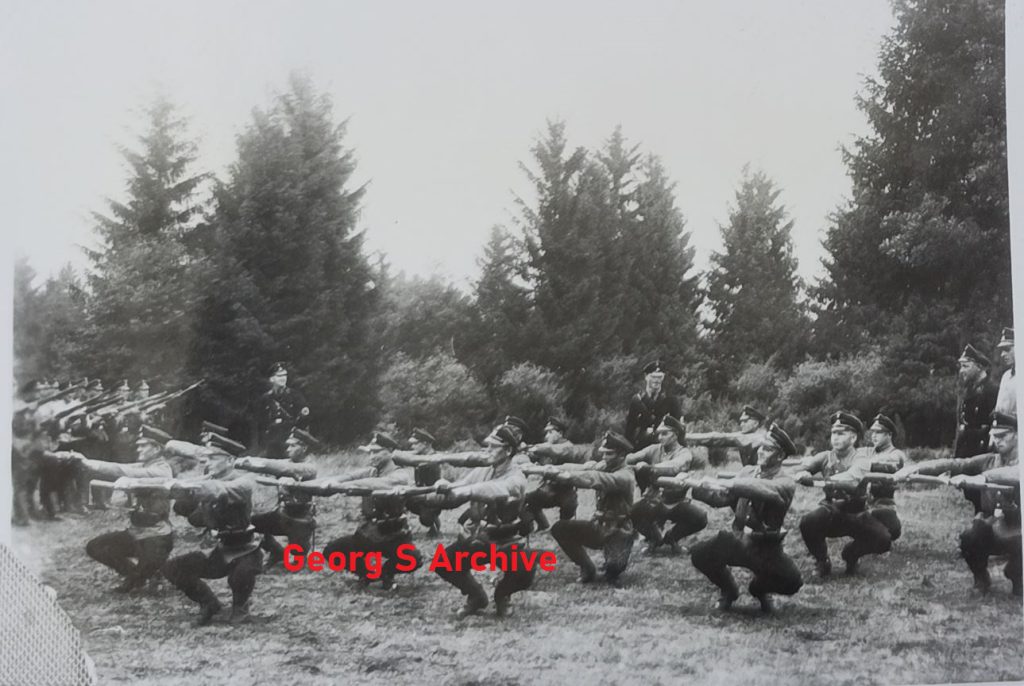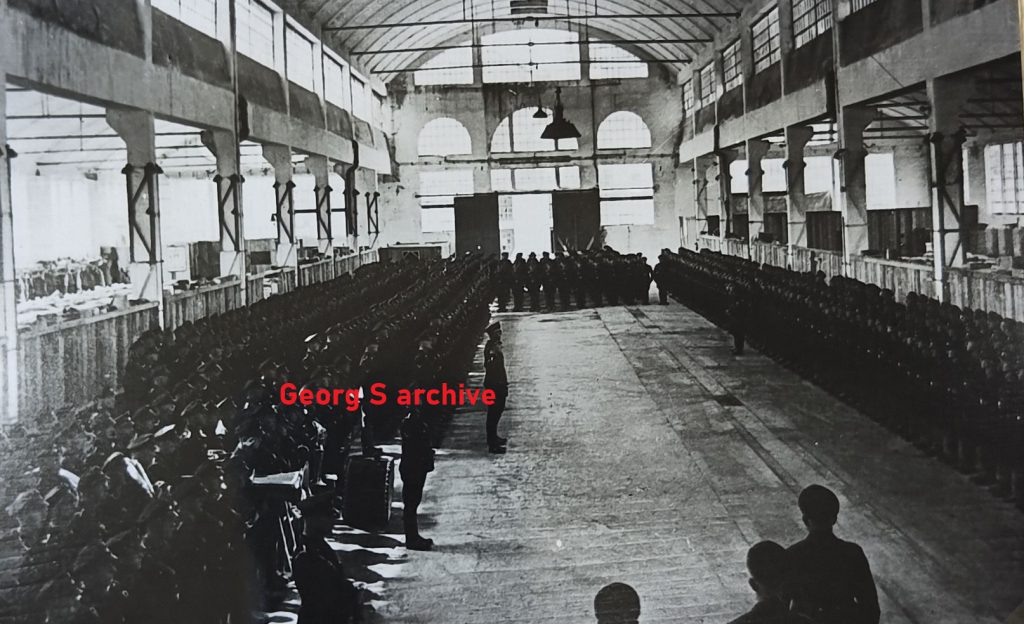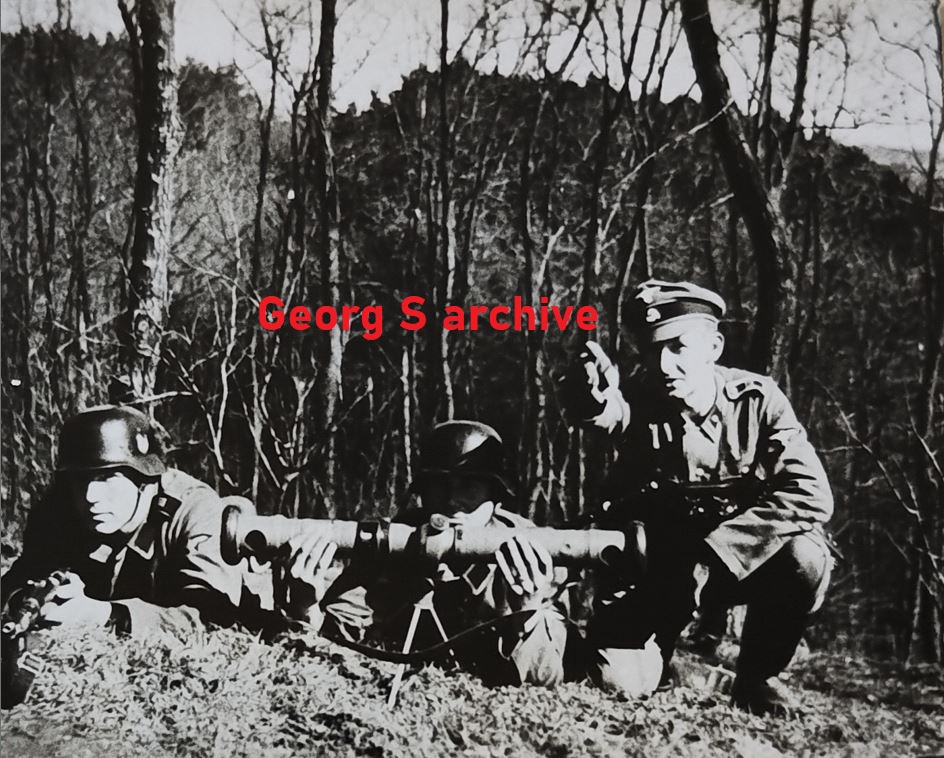August 15, 1940
A turning point in the history of the SS-VT and the SS-TV – officially known as the “Waffen-SS” – was the formation of the SS Leadership Main Office on August 15, 1940
The Reichsführer-SS Berlin, August 15, 1940
Tgb.No. 1107/40 go.
Distributor: see appendix
With effect from August 15, 1940, the SS leadership headquarters of the Reichsführer-SS and head of the German police was established.

The Reichsführer-SS, as leader of the entire SS (General SS and Waffen-SS), uses the leadership office as a command authority for the military leadership of the Waffen-SS (as long as its units are not subject to the Ob.d.H in special operations) and for the preliminary and post-military leadership and education of the General SS.
The main management office includes:
The Waffen-SS command with the offices, inspections and offices previously subordinate to it:
32.) SS-Verw.Ers.Abt. Dachau
49.) SS-Standort-Kdtr. Dachau
58.) SS-Hauptzeugamt Dachau
65) K.L. mit SS-Totenkopfsturmbann (4 Kp.) Dachau
76.) SS-Sanitätsschule der Waffen-SS Dachau
80.) SS-Lazarett Dachau
90.) G.u.V. Prüfstelle Dachau
97.) SS-Bekleidungswerk der Waffen-SS Dachau
98.) Beschaffungsstelle der Waffen-SS Dachau
115.) Wirtschaftsinspektion d. Waffen-SS „Süd“ München-Dachau
119.) Heimatverw. d. SS-T.-Division Dachau
129.) SS-Standortverwaltung Dachau
141.) SS-Verwaltungsschule Dachau
The SS location tour in Berlin
The offices, inspections and departments mentioned under a – e will be eliminated on August 15th. Resigned from the SS main office in 1940.
The Reichsführer-SS
Signed H. Himmler (Mehner, p.14)
The Reichsführer-SS Berlin, August 15, 1940
Tgb.No. 1108/40 go.
Distributor: see appendix (in the appendix, Mehner, p.14)
I will be taking over the leadership of the SS Main Office, which was established on August 15, 1940, until further notice.
I appoint SS brigade leader Jüttner as chief of staff.
The Reichsführer-SS
Signed H. Himmler

According to the Waffen-SS command, Ia, Tgb.No. 78/40 g.Kdos of August 1, 1940, it was ordered that current correspondence until July 31, 1940 should be carried out under the name Command of the Waffen-SS, Chief of Staff, Oranienburg, and all correspondence from August 1, 1940 to SS Command Headquarters, Waffen-SS Command, Berlin-Wilmersdorf, Kaiserallee 188. (Mehner, p.14)
With the establishment of the SS Leadership Main Office as the command authority for the military leadership of the Waffen-SS, an extensive reorganization of the existing Waffen-SS units took place.
New units were set up, existing ones were reclassified and others were dissolved. This also involved a change in the previous locations of the units.
This particularly affected the reinforced SS Totenkopf standards, which were issued on the orders of the SS-FHA v. On September 12, 1940, as part of the uniform orientation of all Waffen-SS units, they had to be reclassified according to the principles applicable to an Inf.Rgt (mot).
(DF 3/1973, p.23)
The SS-FHA, Ref.: 10n14/Ba/Pe v. September 25, 1940, warned on that day: “… There is reason to point out that according to the command of the Waffen-SS, Ia/Tgb.No. 78/40 g.Kdos from August 1, 1940 the inspection of the SS Totenkopf standards was dissolved. …” (Mehner, p. 14)
This order initially appears to have had little impact in the Dachau location area, compared to the Sachsenhausen-Oranienburg location, where there were also some replacement units or training units of the SS-TV??!!
October 5, 1940
SS-FHA, Ia, Tgb.No. 127/40 g.Kdos v. October 5, 1940 regarding
Relocation of the SS-T-Inf.Gesch.Ers.Kp. Dachau
Relocation from Dachau m.W. v. October 20, 1940 to Hamburg-Langenhorn, where the company was subordinated to the E/S “Germania” in terms of training and discipline.
As part of the reorganization of the Waffen SS replacement units, the company was renamed “SS-T-IG-Ers.Kp.” dissolved and now formed the “2.SS-IG-ErsKp.”.
1941
January 1, 1941
Renaming of the SS Totenkopf Artillery Replacement Department, Dachau, as of January 1, 1941, to III. Department of the SS Artillery Replacement Regiment and at the same time incorporated into the regiment.
(Vopersal, Sold., Kämpf., Kam, Vol. 1, p. 324)

March 30, 1941
On March 30, 1941, the order to set up the
Replacement Administrative Services Unit 03/30/41 – 05/14/41
Replacement Department of the SS Administrative Services 05/14/41 – 05/31/44
Training and Replacement Department of the SS Administrative Services June 1, 1944 – April 27, 1945
in Dachau.
April 8, 1941
On April 8, 1941, the III. Department of the SS Artillery Replacement Regiment to Munich-Freimann. (Vopersal, Sold., Kämpf., Kam, Vol. 1, p. 324)
April 20, 1941
Promoted to Standartenführer, Gustav Diesterweg was appointed Commander of the SS Weapons Master School in Dachau, which was renamed again on September 1, 1941:
SS-Waffenmeisterschule München-Dachau 20.04.41 – 01.09.41
SS-Waffenmeisterschule München-Dachau
Waffentechnische Lehranstalt der SS München-Dachau 01.09.41 – 00.04. 20.04.41 – 01.09.41
From the information sheet of the SS-FHA, Weapons Inspection, for the careers of weapons master personnel in the Waffen-SS from September 1, 1941:
The Waffen-SS weapon master staff consists of:
I Weapon Master’s Assistant
II technical sub-commanders (W)
III technical guides (W)
You are responsible for maintaining and repairing the weapons and equipment.
General:
Admission conditions: Entry times and length of service according to the information sheet for joining the Waffen-SS as a volunteer, which is available from the SS supplementary offices.
For those named under I – III, only those men who can present the certificate of having passed the industrial skilled worker examination or the journeyman’s certificate from a chamber of crafts or guild of the completed practical apprenticeship as mechanics, machine fitters, machine builders, tool makers, tool fitters, gauge filers, are eligible for consideration. Precision mechanic or gunsmith. Applicants who have completed their apprenticeship in industrial companies will receive preference.
The request for employment must specifically express the desire to work as a weapons master’s assistant.
Service career:
I. Weaponmaster assistants:
1 year front service. In the last quarter of this year, the applicants will be sent to the military armory in the afternoon to prove their suitability for later use in the armory service.
At the beginning of the second year of service, those suitable are permanently assigned to the armory as assistants and receive further training in a special weapons master’s assistant course lasting 4 months at the SS Munich-Dachau Weapons Technical Training Institute. There will be an exam at the end of this course. Based on the results of this test, a decision must be made:
1.) Whether the examinee is suitable as a weapon master’s assistant in the troops or whether he is unsuitable for weapons technical services – if he is unsuitable, he returns to the front.
2.) Whether the examinee is suitable for a junior commander career in the weapons service. If you are suitable, you must attend a one-year non-commissioned leader course at the SS Weapons Technical Training Institute.
After completing the one-year course at the SS Weapons Technical Training Institute, those found suitable for a weapons-technical leadership career receive a further 1 ¼ years of training to become weapons-technical leaders at the SS Weapons-Technical Training Institute.
Participation in the sub-leader or leader course requires a 12-year service commitment.
II. Achievable ranks as technical sub-commanders (W):
SS-Unterscharführer to SS-Hauptscharführer
In the last years of the 12 years of service, it is possible to attend technical colleges for administration and technology, at the end of which the final examination I (lower career) or the final examination II (middle upper career) can be taken.
III. Weapons technical guides:
After completing the weapons master’s assistant course and after completing 12 years of service, if you are suitable, you will be assigned to a weapons technology course at the SS weapon technology training institute, which corresponds to the courses at a higher technical training institute. Training at the SS Weapons Technical Training Institute lasts 2 ¼ years.
These courses conclude with the technical examination. Leader (W) while simultaneously taking the engineering exam – specializing in mechanical engineering.

As a result, appointment as weapons technology leader and SS-Untersturmführer takes place after a total period of service of 4 ½ to 5 years.
Available ranks:
SS-Untersturmführer to SS-Obersturmbannführer
The technical leaders W who have not yet taken the final examination II (examination for the advanced technical inspection and acceptance service) due to previous weapon master training at an army weapon master school or who have not yet been able to take it due to the conditions at the time, have this examination at the weapons technology training college of the SS Munich – Dachau in order to be able to advance further through the position of SS-Hauptsturmführer.
Care and provision:
Care and provision for members of the Waffen-SS is carried out in accordance with Wehrmacht care in accordance with the SS Welfare and Supply Act. After being released from the Waffen-SS, a career as a civil servant is possible, especially in the police, secret state police, customs, etc. The most extensive financial support is provided when purchasing a settlement. Those who have served for 12 years receive a civil pension certificate.
(Jörg-M. Hormann, The Ordinance Gazette of the Waffen-SS – A Selection, Fitsch-Form-Verlagsgesellschaft Hannover, 1980, pp. 22-23)
April 24, 1941
SS-FHA, Ia/G./Keu, Tgb.No. 1484/41 go to v. April 24, 1941
Re: Composition of the Waffen-SS
According to the supplements:
32.) SS-Verw.Ers.Abt. Dachau
49.) SS-Standort-Kdtr. Dachau
58.) SS-Hauptzeugamt Dachau
65) K.L. mit SS-Totenkopfsturmbann (4 Kp.) Dachau
76.) SS-Sanitätsschule der Waffen-SS Dachau
80.) SS-Lazarett Dachau
90.) G.u.V. Prüfstelle Dachau
97.) SS-Bekleidungswerk der Waffen-SS Dachau
98.) Beschaffungsstelle der Waffen-SS Dachau
115.) Wirtschaftsinspektion d. Waffen-SS „Süd“ München-Dachau
119.) Heimatverw. d. SS-T.-Division Dachau
129.) SS-Standortverwaltung Dachau141.)
141.) SS-Verwaltungsschule Dachau
(Kurt Mehner, Waffen-SS und Ordnungspolizei, Norderstedt, 1995, S. 30-33)
September 1, 1941
On September 1, 1941, the SS Command Main Office, SS Medical Office, announced in the Waffen-SS Ordinance Gazette, 2nd year 1941, No. 16, Number 352 of September 1, 1941:
P.u.V. test centers:
a) For the G.u.V. testing centers, the name “Sanitary Inspection of the Waffen-SS” is no longer used.
From now on it says:
“Health and Usage Testing Center of the Waffen-SS Dachau”
or Prague or Hohenlychen.
The designation “Commander of the G.u.v. testing center” must now be replaced by the designation “Leader of the G.u.V. testing center.”
Furthermore, the designation “near the SS hospital Dachau” or Prague or Hohenlychen is no longer used. It is now only called “G.u.V.-Teststelle Dachau” or Prague or Hohenlychen. –
b) A welfare center for circulatory patients will now be set up at the G.u.V. testing center of the Waffen-SS Dachau. The G.u.V. test center Dachau and the welfare office report to the leader of the G.u.V. test center. –
SS members who require circulatory monitoring and are temporarily unfit for service are referred to the welfare office. –
(Jörg-M. Hormann, The Ordinance Sheet of the Waffen-SS – A Selection, Fitsch-Form-Verlagsgesellschaft Hannover, 1980, see also BA-MA N 756, Wolfgang Vopersal, G.u.V.-Prüfstelle Dachau, n.d., 1 page)
The G.u.V. test center in Dachau was dissolved at a previously unknown point in time.
(BA-MA N 756, Wolfgang Vopersal, G.u.V.-Prüfstelle Dachau, undated, 1 page)
November 15, 1941
After the first SS teaching kitchen was built in Oranienburg in 1940/41, a similar facility was also founded in Dachau a few months later.
In a notice in the Waffen-SS Ordinance Bulletin dated November 15, 1941, number 442, reference is made to the teaching kitchen in Dachau, but it was not yet in operation in September 1942.
The first course in Oranienburg did not begin until the end of July 1942. 24 troop cooks were trained there in two-week courses
(Hermann Kaienburg. The military and economic complex of the SS in the Sachsenhausen-Oranienburg concentration camp site, Metropol-Verlag 2006, pp. 340 – 341, see also note 560
December 15, 1941
Regarding the SS location headquarters in Dachau, according to the SS-FHA, Org.Abt. Tgb.No. 5539/41 from December 15, 1941: Reported to the SS-FHA, subordinate to the SS Dachau location command
a) a guard company in Dachau for the SS site guards and the Munich guard of honor
b) a guard company on the Obersalzberg for the guard of honor
c) the commanded company in Dachau
d) the SKD special column on the Obersalzberg
(see also Kurt Mehner, Waffen-SS and OrPo, p. 279)
End of part 5
Author Roland Pfeiffer, some Images Georg Schwab


